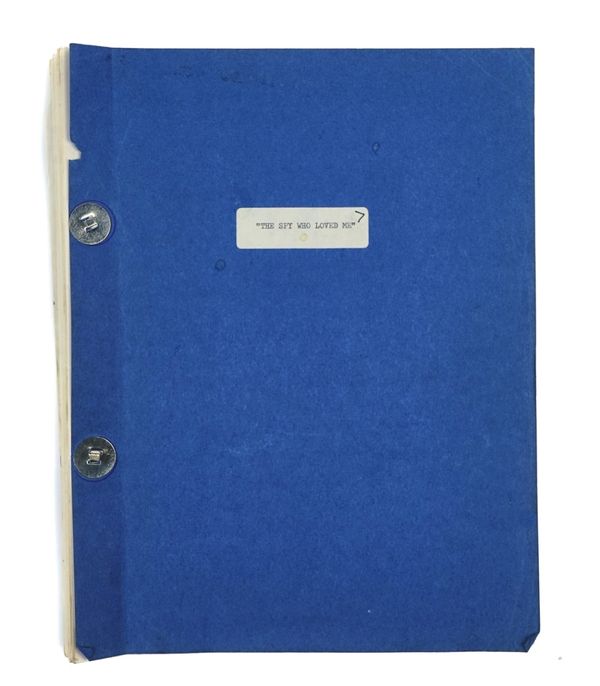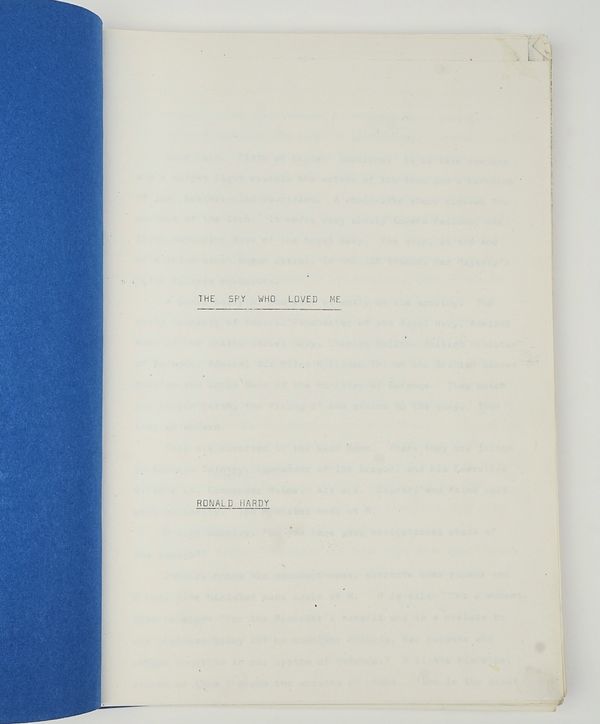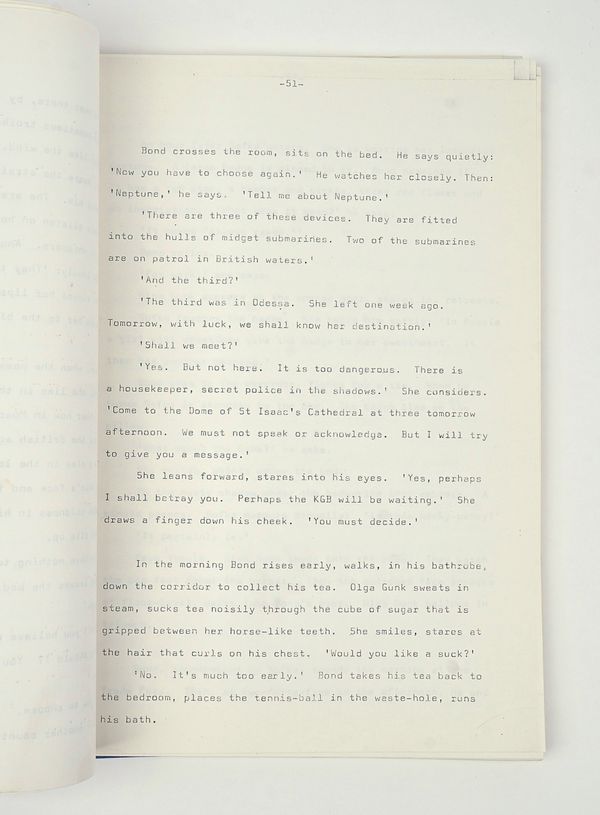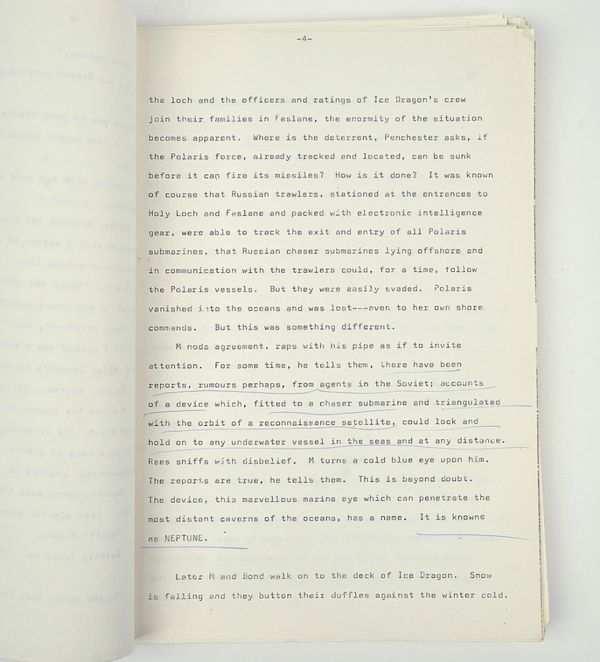JAMES BOND ‘THE SPY WHO LOVED ME’, 1977 – AN EARLY FILM TREATMENT BY RONALD HARDY
| Estimate: | £2,000 - £3,000 |
| Hammer price: | £1,800 |
An early mimeographed typescript of Ronald Hardy’s treatment for the screenplay, entitled The Spy Who Loved Me, Ronald Hardy, undated [but pre 5 Nov. 1975], 126 pp. [p.121missing] in blue card covers fastened by two circular metal clips, the cover with white paper typescript label annotated in black ink with a small arrowhead symbol, 13 pages with annotations in both pencil and ballpoint pen, mostly underlining, probably in Gilbert’s hand, giving emphasis to key elements in Hardy’s story; the plot centred on a Soviet threat which took the form of a sophisticated electronic tracking device which enabled the villains to pinpoint and capture enemy nuclear submarines from any distance.
Ronald Hardy came approximately second in line in the order of twelve different scriptwriters Cubby Broccoli employed to tackle the screenplay for The Spy Who Loved Me until he got the script he wanted.
Hardy’s plot involved a Soviet threat of unprecedented danger to the Western World. The threat took the form of a device called ‘Neptune’ fitted to three small submarines and linked to a reconnaissance satellite which could then lock and hold onto enemies’ nuclear submarines at any distance. M sent 007 and two other 00s, 006 and 008 [the latter who set himself as an intense rival to Bond] to find and neutralise Neptune in the USSR without being detected. The West had been tipped off about Neptune by a Russian double agent - beautiful prima ballerina Helen Andreyevna who danced for the Kirov State Ballet Company of Leningrad. Helen and Bond’s stories become intertwined with dramatic sequences involving skis and sleds in Kitzbuhel, Troikas in Leningrad, chases and amusing interludes with Bond’s discus-thrower KGB minder, Olga Gunk in Leningrad; undercover episodes on the Island of Kotlin in the Gulf of Finland, and numerous fights, most notably in an airship above the sea with the main KGB foe Colonel Sukov, when the microfilm of Neptune’s plans obtained by the two Spy Lovers, and housed by Helen in a famous Faberge egg made for the Tsar, falls into the water, and the finale, a savage fight in Helsinki in a sauna room in the Hotel Finlandia-Royal, when 008, who’s been despatched by M to kill 007’s lover double-agent Andreyevna, tries to kill 007 telling Bond: ‘You said I had to kill you first’ 007 prevails over 008 - the mission is over. The story ends with the two Spy Lovers going their separate ways, Helen as a famous ballerina, could not go into hiding, and Bond admits he couldn’t protect her. Helen tells 007 “I love you my James... but I have to dance…So we must go our separate paths...One night I’ll look up from the stage and you’ll be there. You can throw me a rose. A red rose” . She leaves alone on the Stockholm ferry.
Thus here, in Hardy’s treatment, the foundations were laid for a few key plot elements that were continued and developed throughout the later re-writes of the screenplay for The Spy Who Loved Me.
Condition Report: Overall good. Blue card cover with small area of paper loss on left hand margin and creased at corners.. A number of inside pages rubbed at corners, some corners folded
Footnote: The Spy Who Loved Me (1977), the tenth in the Eon Productions official 007 series, initiated a number of records for the James Bond franchise. It was Cubby Broccoli’s first solo 007 venture without co-producer Harry Saltzman, and he was determined that it should become the biggest and best Bond yet. From the outset, the film’s path to success was beset with numerous difficulties and the screenplay itself went through more adaptations and revisions than any production during the 40-year history of 007 on screen. Problems began with Ian Fleming’s source material for the film’s title. Like the movie, it was Fleming’s tenth Bond novel in order, however it represented a departure from Fleming’s usual 007 format in that it is told from the viewpoint of a young Englishwoman who only meets the famous spy in the last few chapters of the book. For this reason, Fleming never wanted this book to be sold as a film project. His estate, however, gave Broccoli permission to use the novel’s title only. The book and film do also share one significant common element – Jaws, who is loosely based on Fleming’s villain, `Horror’, who had steel-capped teeth. Nevertheless, the screenplay for The Spy Who Loved Me is considered to be the first Bond film whose story is completely original. After a visit to Russia, Broccoli devised a plot for a new story which suited the film’s title and focused on a beautiful Russian agent who falls in love with James Bond.
It is said that twelve different screenwriters worked on fifteen separate drafts for the screenplay over a period of three years, in one of the most fiendishly complicated film pre-production processes in Eon’s history. Considering the quantity of different variants of the screenplay here in Lewis Gilbert’s personal film script archive, it appears that just over half of the fifteen screenplay versions are represented between lots 13-18.
Looking through the different variations of treatments and screenplays for The Spy Who Loved Me, a large proportion of which are represented in this collection, in the words of film historian Steven Jay Rubin they : “…offer a textbook look at script development…the material is priceless, since it allows the reader to see how typical Bondian situations are workshopped…”
Literature:
RUBIN, Steven Jay Spy Who Loved Me Script Wars in The James Bond Movie Encyclopaedia, Chicago Review Press Incorp. Chicago, 2021
GILBERT, Lewis All My Flashbacks The Autobiography of Lewis Gilbert, Sixty Years A Film Director, Reynolds & Hearn, London, 2010
FIELD, Matthew & CHOWDHURY, Ajay Some Kind Of Hero, The Remarkable Story of The James Bond Films, Cheltenham Glouc., 2015
The Spy Who Loved Me Script History www.M16-HQ.com
www.IMDB.com
Bellmans is grateful to Wallace and Hodgson for their assistance with cataloguing the Lewis Gilbert Film Script and Production Archive.



